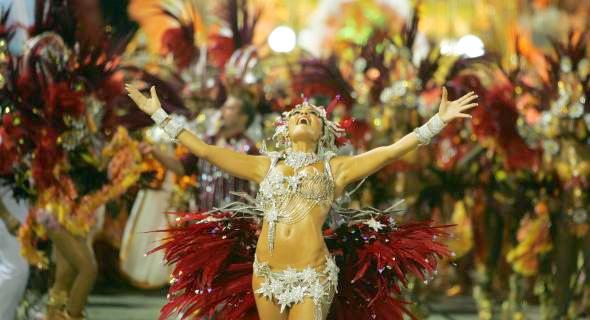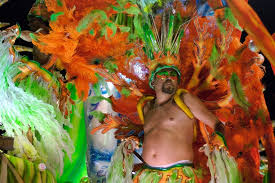Mardi Gras of the World Series- Brazil!!
Brazilian Carnival, accurately spelled Carnaval, is an annual festival in Brazil. It is held four days before Ash Wednesday, the day of fasting and repentance that marks the beginning of Lent.
Rio de Janeiro is the most famous city for carnival in Brazil. In carnival the different samba schools compete for the first place in elaborate parades that last for hours. In carnival all dancers wear incredible costumes of sequins and feathers. Rio became famous in the 1930′s for their parades, parties, and balls, which become larger and more impressive every year. The parade’s history began in 1928 and used to take different routes through the city before settling on its current path. Carnival parades pass through the enormous Sambodromo, a sort of long stadium. If you want to join in the samba parade, samba schools are always looking for extra performers to be part of the show.
Carnival is the most famous Brazilian holiday. During this time, Brazil attracts 70% of its tourists. Variations in carnival celebrations are observed throughout the multitude of Brazilian cities. Yet, a commonality observed among them is the incorporation of samba into the celebrations. The southeastern cities of Brazil have massive parades that take place in large sambadromes. The largest carnival celebration in Brazil and the world occurs in Rio de Janeiro, where two million people celebrate in the city. The city of Salvador also holds a large carnival celebration.
The carnival begins when Rio’s mayor hands over a huge gold and silver key to Rei Momo, the Fat King. A very large number of mini street parties are held prior to the carnival proper getting underway. Smaller local parades known as blocos are held across the city and attract thousands of spectators. Despite there being 17,000 portable toilets dotted around the city for the carnival, a Pee Patrol has been appointed to clamp down on revellers urinating in the streets. Over 1/4 million jobs will be created by Carnival and it will generate £420 million for local hotels, restaurants and bars. Carnival is Brazil’s most important festival but celebrations are held in Sao Paulo, Salvador, Olinda, Recife, Manaus and Porto Alegre.
20 Interesting facts about Rio Carnival from the Trinidad Express–
1. The carnival is a wild four-day party held 40 days before Easter.
2. It started yesterday and ends on ‘Fat Tuesday’, the day before the start of Lent, Ash Wednesday.
3. February is the hottest month of the year in Rio and the city is at its liveliest.
4. The roots of the carnival can be traced back to the Romans and Greeks who celebrated the arrival of spring with parties.
5. These traditions were carried over to the New World with Portuguese immigrants in the 1700s.
6. Their ‘Entrudo’ festival saw revellers throwing water, limes, mud and even food at each other.
7. Brazil’s carnival evolved over time with the addition of masquerade balls and then big street parades with groups of people playing music and dancing.
8. Today, carnival takes place in the city’s streets, bars and clubs.
9. Hundreds of street bands, singers and orchestras will entertain party-goers largely with samba music.
10. The carnival highlight, though, is the Samba Parade, a fierce competition between Rio’s samba schools, of which there are nearly 200.
11. Held in the purpose-built Sambodromo, the schools are judged on their elaborate floats, costumes, dancing and music.
12. Some of the schools are expected to spend up to £3 million on outfits and preparations.
13. The city’s poorest residents, from the slums, typically make up the majority of the schools.
14. Around two million people per day are expected to take to the streets this year.
15. The carnival begins when Rio’s mayor hands over a giant silver and gold key to Rei Momo, the Fat King.
16. Scores of mini street parties are held prior to the carnival proper getting underway. Smaller local parades known as ‘blocos’ are held across the city and attract thousands of spectators.
17. Despite there being 17,000 portable toilets dotted around the city for the carnival, a Pee Patrol has been appointed to clamp down on revellers urinating in the streets.
18.1/4 million jobs will be created by Carnival and it will generate £420 million for local hotels, restaurants and bars.
19. Carnival is Brazil’s most important festival but celebrations are held in Sao Paulo, Salvador, Recife, Olinda, Manaus and Porto Alegre.
20. Carnival attracts more and more celebrities with Jennifer Lopez attending last year’s event and Gangnam Style star Psy expected this weekend (from 2014).
************
Rio and New Orleans are often considered the most desirable Carnivals to visit. I’ve been to Rio, but not for Carnival. I’m very tempted to go in the near future. Since my parade, Krewe du Vieux, rolls very early- January 31 for 2015- I can participate in my parade and the first weekend here before flying to Rio. I’m getting excited just writing this entry!


Leave a Reply